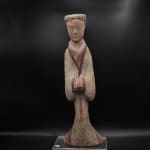Set of Eleven Western Han Attendants, 206 BCE - 9 CE
Terracotta
44.5 x 10.2 cm
17 1/2 x 4 in
17 1/2 x 4 in
NP.006
The Han Dynasty, like the Zhou before it, is divided into two distinct periods, the Western Han (206 B.C.-9 A.D.) and the Eastern Han (23-220 A.D.) with a brief interlude....
The Han Dynasty, like the Zhou before it, is divided into two distinct periods, the Western Han (206 B.C.-9 A.D.) and the Eastern Han (23-220 A.D.) with a brief interlude. Towards the end of the Western period, a series of weak emperors ruled the throne, controlled from behind the scenes by Wang Mang and Huo Guang, both relatives of empresses. They both exerted enormous influence over the government and when the last emperor suddenly passed away, Mang became ruling advisor, seizing this opportunity to declare his own Dynasty, the Xin, or “New.” However, another popular uprising began joined by the members of the Liu clan, the family that ruled the Han Dynasty, the Xin came to a quick end and the Eastern Han was established in its place with its capital at Loyang (Chang’an, the capital of the Western Han, was completely destroyed).
However, even as Chinese influence spread across Southeastern Asia into new lands, the Eastern Han Dynasty was unable to recreate the glories of the Western Period. In fact, this period can be characterized by a bitter power struggle amongst a group of five consortial clans. These families sought to control the young, weak emperors with their court influence. Yet, as the emperors became distrustful of the rising power of the clans, they relied upon their eunuchs to defend them, often eliminating entire families at a time. During the Western Han, the Emperor was viewed as the center of the universe. However, this philosophy slowly disintegrated under the weak, vulnerable rulers of the Eastern Han, leading many scholars and officials to abandon the court. Eventually, the power of the Han would completely erode, ending with its dissolution and the beginning of the period known as the “Three Kingdoms.”
During the Han period, ceramics, bronze, and lacquerware sculptures flourished, many of which were produced for funerary purposes. Servant and animal figurines were frequently discovered in elaborately decorated grave sites, which the Han likely believed aided in the afterlife. Rich pigments were also used on earthen statues, such as the famous "Han purple"--which was considered to be one of the first human-made pigments widely used. The remains of these sumptuous colours are visible in the details of the figures' garments.
The eleven figures may have been attendants or courtiers in the court. Small earthenware sculptures of standing men, women, and servants are common subject matters in Han Dynasty art. They are dressed in Hanfu, a common traditional garb during the Han Dynasty. The pieces are in good condition, with fine textural details adorning the textile. The serene expressions of the figures are individually and clearly defined.
However, even as Chinese influence spread across Southeastern Asia into new lands, the Eastern Han Dynasty was unable to recreate the glories of the Western Period. In fact, this period can be characterized by a bitter power struggle amongst a group of five consortial clans. These families sought to control the young, weak emperors with their court influence. Yet, as the emperors became distrustful of the rising power of the clans, they relied upon their eunuchs to defend them, often eliminating entire families at a time. During the Western Han, the Emperor was viewed as the center of the universe. However, this philosophy slowly disintegrated under the weak, vulnerable rulers of the Eastern Han, leading many scholars and officials to abandon the court. Eventually, the power of the Han would completely erode, ending with its dissolution and the beginning of the period known as the “Three Kingdoms.”
During the Han period, ceramics, bronze, and lacquerware sculptures flourished, many of which were produced for funerary purposes. Servant and animal figurines were frequently discovered in elaborately decorated grave sites, which the Han likely believed aided in the afterlife. Rich pigments were also used on earthen statues, such as the famous "Han purple"--which was considered to be one of the first human-made pigments widely used. The remains of these sumptuous colours are visible in the details of the figures' garments.
The eleven figures may have been attendants or courtiers in the court. Small earthenware sculptures of standing men, women, and servants are common subject matters in Han Dynasty art. They are dressed in Hanfu, a common traditional garb during the Han Dynasty. The pieces are in good condition, with fine textural details adorning the textile. The serene expressions of the figures are individually and clearly defined.



